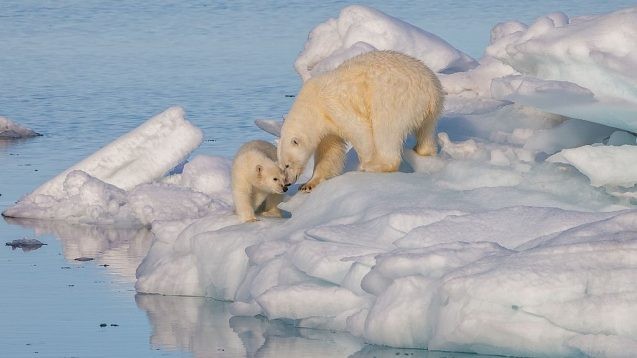You Asked: When Will Polar Bears Go Extinct?
A recent study provides a rough timeline, but there’s still time to save them if we cut our carbon emissions.

“You Asked” is a series where Columbia Climate School experts tackle reader questions on science and sustainability. The following question was submitted by one of our Instagram followers, and the response comes from Robert Newton, a senior research scientist at the Lamont-Doherty Earth Observatory.
Q: How fast will polar bears go extinct at the rate that global warming is happening?

A: Nobody knows for sure if polar bears will go extinct. Whether that happens depends on what happens to the sea ice in the Arctic, which serves as an important habitat for the polar bears’ main food source: seals. And the sea ice depends very tightly on what happens to carbon dioxide emissions, and we don’t know what’s going to happen there. We have projections based on various emissions scenarios but, as Yogi Berra said, the future is very hard to predict before it happens.
What our team found in a recent study, using model runs and basic physics, is that if we continue to emit CO2 into the atmosphere at the historical rates, then sometime in this century, summer sea ice will disappear nearly completely in the Arctic—millions of square kilometers of sea-ice loss. That is a problem for polar bears because their food source, seals, rely on sea ice. They need corrugated and ridged ice, where they can find nooks and crannies and small caves to overwinter in and birth their pups. Those icescapes come from the ice piling up and being compacted over several years. If the ice melts every summer and comes new every winter, then the winter ice will be relatively thin — only about about 1 to 1.5 meters thick — and flat. And that does not make decent habitat for seals. It doesn’t make good habitat for polar bears to den in and to birth their cubs, either.
Some polar bear populations actually can den and birth on land. But even those populations require a thick, corrugated platform of sea ice to hunt for seals. If the seals are not denning and you don’t have pups in the spring, then the polar bears lose a major food source.
At some time later in the century, if things continue as they have been, then the winter ice will also disappear. We don’t know when that will be. The models disagree about exactly how hot it has to get for that to happen. But our best estimate would be towards the end of the 21st century. At that point, it’s hard to imagine significant populations of polar bears surviving.
There is evidence from DNA that some polar bears may be mating with brown bears. So it’s possible that polar bears will evolve away by giving up on the ice, moving back into the forest, and mating with brown bears. But polar bears as polar bears will certainly cease to exist once the ice ceases to exist. They’re not well adapted to hunt on land. They blend in beautifully on the sea ice; they stand out like crazy in the forest. They’re fantastic swimmers, adapted to hunting marine mammals. There’s no reason to think that they would survive if they have to forage and hunt on the tundra or in wooded areas on land.
So, to answer your question, my best guess is that polar bears could go extinct somewhere between 2050 and 2100.
That said, all of the models we’ve run and our understanding of the physics of ice growth and ice melt indicate that the sea ice will follow the temperature of the atmosphere very closely. The sea ice is disappearing very quickly as the northern latitudes warm, but it should also return very quickly if we manage to get greenhouse gas emissions under control and to reduce carbon dioxide in the atmosphere.
That was one of our study’s findings — that if people are able to stabilize the global mean temperature at about two degrees centigrade, then a fair amount of summer ice will persist going forward for the foreseeable future, and the winter ice will persist and there may be enough multi-year ice for polar bears to survive. And if, at some future date, human beings are able to capture carbon dioxide from the atmosphere and sequester it underground to bring global temperatures back down, then there’s every reason to believe that the ice will come back within a few years as the global mean air temperature comes down. So, in that sense, the future of the species is really in our hands.
